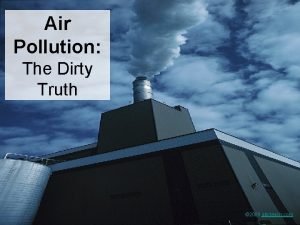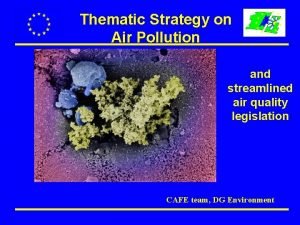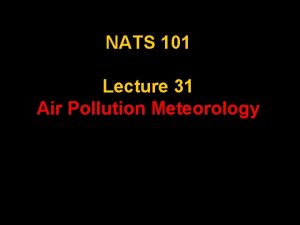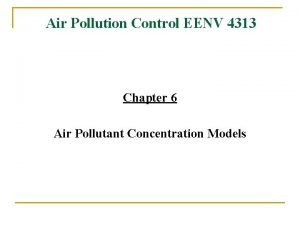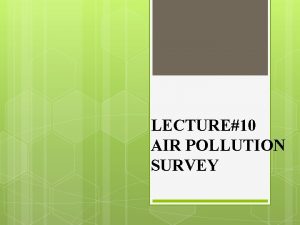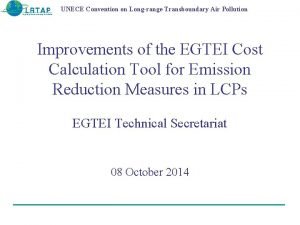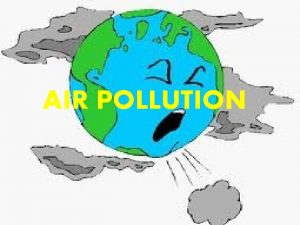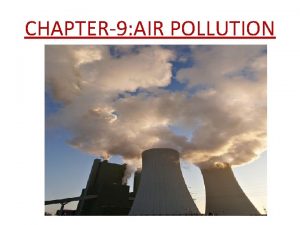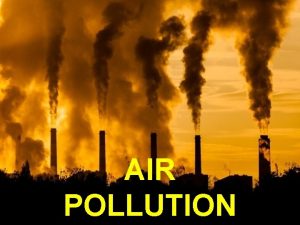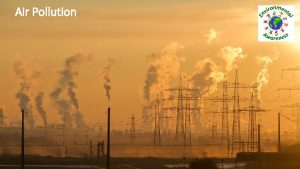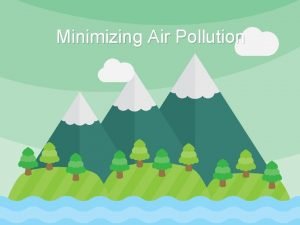CLRTAPWGE activities on air pollution impacts in Austria
















- Slides: 16

CLRTAP-WGE activities on air pollution impacts in Austria Long-term effects of N and S deposition on ecosystems and biodiversity Thomas Dirnböck 1

CLRTAP-WGE activities in Austria University of Innsbruck 2

Emissions follow the European trend NMVOC NH 3 NOx SO 2 PM 2. 5 3

Less acid deposition increased forest soil p. H Acid deposition reduction in forest sites across Austria p. H increase in Austrian forest soils between 1987 and 2007 CLacid exceedance < 1% of forest area 4 Jandl, R. , S. Smidt, et al. (2012). "Acidification and Nitrogen Eutrophication of Austrian Forest Soils. " Applied and Environmental Soil Science 2012:

Recovery in soil acidity did not improve tree nutrition n Soil p. H increased but only in the topsoil n No signs of recovery in deeper soil horizons n Nutrient imbalances even worsened since 1984 corroborating European trends Berger et al. 2016. Env. Poll. http: //dx. doi. org/10. 1016/j. envpol. 2016. 024. 5

Nitrogen Critical Load Exceedance Total NO 3—N 6

More than 50% of sensitive habitats will still experience exeedance of the Clemp by 2020 Flächenanteile von Stickstoff CL Überschreitungen in Österreich und in den Natura 2000 Gebieten. AAE beschreibt den Anteil der Fläche sensibler Habitate für die Überschreitungen auftreten. 1 siehe Tabelle 1 im Zwischenbericht; 2 AAE Berechnungen in 1 km Auflösung. Sensible Habitate 1 Fläche [km²] Flächenan AAE 2005 AAE 2010 AAE 2020 teil [%] >0 >0 > 0 [%] [%] Gesamt Österreich 49. 430 59 95 66 47 Natura 2000 10. 545 83 98 73 54 7

Nitrogen eradicates lichen diversity n Drastic species loss (17 species in ~10 years ICP IM Zöbelboden n Eutrophication through long-term N deposition (ammonia in precipitation and in fog) was the main driver 90 80 70 60 50 40 30 20 10 0 41 47 1999 34 29 44 43 2005 2010 Crustose lichens Macrolichens The cyanolichen Pannaria conoplea, almost extinct at Zöbelboden (Foto: Türk R. ) 8 Mayer, M. , Pfefferkorn-Dellali, V. , Türk, R. , Dullinger, S. , Mirtl, M. , Dirnböck, T. 2013. Significant decrease of epiphytic lichen diversity in a remote area in the European Alps, Austria. Basic and Applied Ecology 14: 396 -403

Where the Critical Load was exceeded the cover of oligotrophic species decreased R²=0. 3 p-value=0. 004 Excess Nitrogen 9 Dirnböck et al. Global Change Biology (2014)

Soils and trees are increasingly N deficient n Decreasing N 1987 -2007 availability in forest soils n Increase in the number of plots showing N deficiency in needles 10 Jandl, R. , S. Smidt, et al. (2012). "Acidification and Nitrogen Eutrophication of Austrian Forest Soils. " Applied and Environmental Soil Science 2012:

Large scale deterioration in tree nutrition n P in particular is becoming limited n Higher tree nutrient demand due to higher growth rates as an effect of N deposition (climate, CO 2) Jonard, M. , A. Fürst, et al. (2015). "Tree mineral nutrition is deteriorating in Europe. " Global Change Biology 21(1): 418 -430. 11

We wanted to know …. …to which extent increasing tree growth is lowering N availabilty and therefore reducing the risk of eutrophication through N deposition? 12

HSI Soil p. H C: N ratio N Dep n Dry sites might be an Temperatur trees during climate warming offsets N deposition effects Nieders. 2100 senarios, 21 forest sites, VSD+/PROPS model n Enhanced N uptake by exception n Overall habitat Tree growth factor suitability worsens due to direct climate effects 13

Climate change mitigates N saturation most where N deposition is/was high sites n Landscape. DNDC coupled C -N modelling n 4 GCM scenarios until N deposition n 8 ICP Forests and ICP IM 2100 n CLE, MFR, B 10 N deposition scenarios Reduction per 1°C warming 14

Outlook to future emission scenarios NH 3 NMVOC SO 2 NOx PM 2. 5 15

Conclusions n Recovery from acidification is very slow in forests n Forest growth increase during the last decades might have mitigated stronger N effects n Climate change can offset N deposition effects in future in Austrian forest ecosystems n Drier forest areas with high N deposition remain at risk n Very complex and still uncertain – monitoring and further research n More knowledge needed about N deposition effects in semi-natural/natural grassland n Ammonia remains an issue 16 Contact: thomas. dirnboeck@umweltbundesamt. at
 Section 1 what causes air pollution
Section 1 what causes air pollution Chapter 12 air section 1 what causes air pollution
Chapter 12 air section 1 what causes air pollution Air higroskopis air kapiler dan air gravitasi
Air higroskopis air kapiler dan air gravitasi Now group these activities into indoor and outdoor
Now group these activities into indoor and outdoor Primary and support activities
Primary and support activities Primary activities and secondary activities
Primary activities and secondary activities The statement of cash flows helps users
The statement of cash flows helps users Main cause of air pollution
Main cause of air pollution Air pollution
Air pollution Land pollution effects on human health
Land pollution effects on human health Air pollution
Air pollution Air pollution simulator
Air pollution simulator Air pollution control engineering noel de nevers solution
Air pollution control engineering noel de nevers solution Objectives of air pollution
Objectives of air pollution Adjectives for air pollution
Adjectives for air pollution What is a primary air pollutant
What is a primary air pollutant Conclusion of air pollution
Conclusion of air pollution







